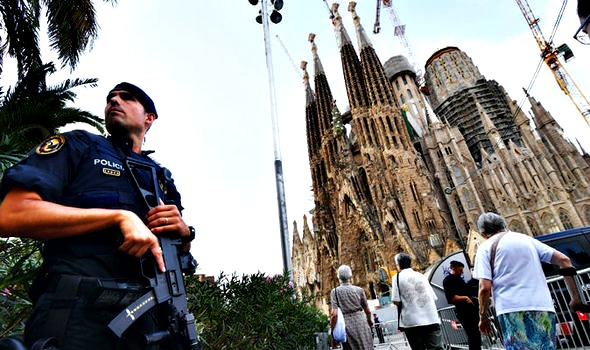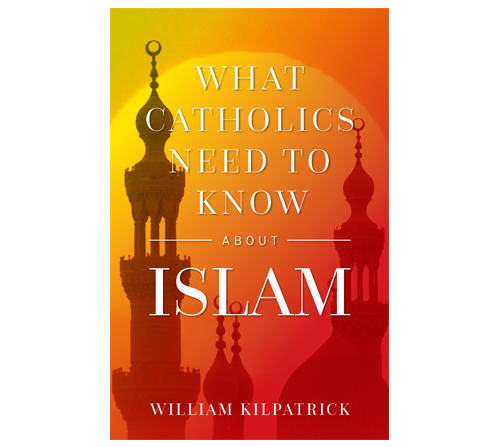Most Catholics in the U.S. are vaguely aware that Christians are being persecuted in the Middle East, Africa, and other parts of the Islamic world. Most are aware of the many terrorist attacks in Europe. And most are aware of the major jihad attacks here in America.
But if you’re mainly focused on the occasional terror attack, you are probably underestimating the extent of the Islamic threat and the speed with which it is spreading. That’s because people have short memories. Take the recent terror attacks in Spain—in Barcelona and Cambrils. You undoubtedly saw some of the news coverage of the carnage, and you probably think you won’t forget the event. But memories fade. How many remember the much more deadly jihad attack on the Madrid train system in 2004? The nearly simultaneous bombings aboard four commuter trains killed 191 people and injured more than 1,800. But, unless you live in Spain, the Madrid train bombings passed out of your mind years ago, and if you’re under twenty-five, you likely never knew about them in the first place.
When a spectacular terror attack occurs, the average person is temporarily alarmed, but then settles back into a state of complacency until the next major terror attack triggers the alarm once again. But this cycle of alarm-complacency-alarm-complacency doesn’t bring us any closer to understanding the underlying problem or solving it. Indeed, it conditions us to live with a certain level of terror. We know that the jihadists will strike again, but we also know that the odds are low that we will be among the victims. And so we manage to get on with our lives. As long as bombs are not going off in nearby subways or buses we stop thinking about jihad.
Our society’s focus on acts of violent jihad makes us forget that there is another, more subtle kind of jihad that we need to worry about. Terrible as violent jihad is, cultural jihad is actually a greater threat. Violent jihad –9/11, Barcelona, London Bridge– is intermittent, but cultural jihad never sleeps. It is active 24 hours a day and 365 days a year. And though your odds of being a victim of violent jihad are quite low, your odds of being a victim of cultural jihad are exceedingly high.
Cultural jihad is a long-term campaign to influence and even co-opt key social institutions such as schools, churches, media, business, and courts. For example, chapters of the Muslim Brotherhood-linked (and politically active) Muslim Student Association can be found on every major campus. And substantial grants from Gulf State kingdoms have persuaded American universities to adopt Islam-friendly policies and curriculums. Catholic colleges are no exception. Most of them present a whitewashed version of Islam to their students. And some Catholic institutions, such as Georgetown, have become little more than PR agents for the Islamic way of life.
In addition, Islamists have been quite successful in penetrating federal government agencies, including security agencies. As just one example among many, consider that a gentleman named Mustafa Javed Ali was recently appointed as Senior Director for Counterterrorism at the National Security Council. The problem here is not that Javed Ali is a Muslim, but that his last job was with the Council on American-Islamic Relations (CAIR)—an organization with links to terror organizations.
CAIR is the quintessential cultural jihad organization. It has a small army of lawyers at its disposal, and it will sue you at the drop of a hijab if you should dare to oppose its agenda. CAIR is just one of an alphabet soup-full of Islamic organizations that work tirelessly to transform American society into a sharia-compliant society. CAIR, ISNA, ICNA, MAS, MSA, USCMO—there are about 50 major cultural jihad organizations in the U.S., and hundreds of minor ones. Think of them as akin to the many leftist groups that work night and day to turn America into a utopian socialist state. The leftists will sue you if you don’t bake a cake for a gay wedding, and the cultural jihadists will sue you if you don’t make it with 100 percent halal ingredients.
It is largely through cultural jihad (aka “stealth jihad”) that Islamic law and culture is spreading through the West. If you don’t worry about it, it’s because you probably don’t know much about it, and if you don’t know much about it it’s because you’re not meant to know.
Cultural jihad never sleeps, but the cultural jihadists prefer that you remain asleep to what they’re doing. In this endeavor, they receive a great deal of help from corporate America. Media giants such as PayPal, Facebook, and Google are doing their best to shut down the websites that call attentions to cultural jihad. Recently, for example, PayPal blocked the JihadWatch website in response to a spurious claim that Jihad Watch was a hate group. Not long before that Google had readjusted its search engine algorithms in order to make it difficult for searchers to find JihadWatch. And on other occasions Facebook has suspended the Jihad Watch account.
Numerous other counter jihad sites in America and Europe have been censored in a similar fashion. The aim is to choke off funding to groups that are critical of Islamists or to shut them down completely. So when the terrorists strike, the giant media monopolies strike back not against the stealth jihadists who enable the terrorists, but against those who are attempting to expose the connection between cultural jihad and violent jihad. The cultural jihadists are winning the information war because the media conglomerates and the universities have sided with them and against their critics. If you try to provide accurate information about the Islamist threat, you’re not only up against CAIR’s lawyers, you’re up against the universities, the media, and much of corporate America.
When violent jihadist strike we look to police and the military to protect us. But the spread of Islam is not simply a military matter, it’s also a culture war. And while soldiers are trained to resist an advancing enemy, the average citizen is not trained to resist cultural warfare. On the contrary, he has been conditioned to accept all diversities—even totalitarian systems that are out to subjugate him.
That’s where the Catholic Church comes in—or, more accurately, ought to come in. Historically, the Church was a bulwark of resistance against Islamic encroachments– and not just Islam, but other totalitarian movements as well. The Church warned about the dangers of communism decades before anyone else saw the problem. Moreover, St. John Paul II played a major role in bringing an end to communism in Eastern Europe. Likewise, throughout the 1930s, while the smart set in Britain and America celebrated Hitler’s “progressive” ideas about eugenics, the Catholic Church spoke out repeatedly against Nazi racism. Pope Pius XI called Hitler “the greatest enemy of Christ and of the Church in modern times,” and in 1937, when much of Europe was still asleep, Pius issued the famous anti-Nazi encyclical Mit Brennender Sorge.
Sadly, in recent years the Church has not provided any similar guidance about the totalitarian nature of the Islamic threat. Insofar as Church leaders have offered advice on the subject, it has been bad advice: calls for solidarity with Islam, reassurances that Islam is a close cousin to Catholicism, and repeated claims that Islamic terror has nothing to do with Islam.
Pope Francis himself has been one of the main defenders of Islam. In Evangelii Gaudium he declared that “authentic Islam and a proper reading of the Koran are opposed to every form of violence.” On another occasion, he told Muslim migrants that they could find guidance in the Koran. And, most recently, he stated that the personal safety of immigrants should always take priority over national security. That’s a high sounding sentiment, but when you think about it it’s just another way of saying that the safety of Muslim immigrants is more important than the safety of Europeans and Americans.
“Always prioritize personal safety [of immigrants] over national security”? Given the proven connection between increased Muslim immigration and increased terrorism, that seems like a rather reckless thing to say. Take the twin attacks in Barcelona and Cambrils which left 14 dead and over a hundred wounded. All of the twelve terrorists were immigrants or the children of immigrants. Their leader, Imam Abdelbaki Es Satty was also an immigrant.
Before becoming an imam, Es Satty was in prison for drug smuggling. After serving his sentence he should have been deported back to Morocco, but a Spanish judge decided that Imam Satty’s safety trumped the safety and security of Spanish citizens, and, thus, he was allowed to stay in Spain and plot away.
The original plot was to attack the iconic Sagrada Familia Cathedral in Barcelona with vans packed with explosives. When the explosives went off prematurely at the site where they were stored, the plot was shifted to smaller car and knife attacks at Cambrils and Las Ramblas in Barcelona. But suppose the original plot had succeeded. About 10,000 visitors tour the Sagrada Familia Cathedral every day. Many hundreds would likely have been killed and hundreds more wounded. Would Pope Francis still say that the safety of immigrants should take priority over national security?
Unfortunately, he probably would. Francis seems constitutionally unable to connect Islam with terrorism, and he seems unaware of the threat posed by cultural jihad—the network of Muslim enclaves, mosques, and Islamist organizations that provide the enabling environment for violent jihadists to do their work.
Cultural jihad never sleeps, but many in our government, universities, and media organizations are asleep to the spread of cultural jihad. Meanwhile, the Church leadership, with Francis at the helm, is in a near comatose state. The Church was once in the vanguard of resistance to Islamic invasions. Now it is more like a sleeping giant—a powerful force for good that is asleep to the dangers posed by Islam’s stealth advance. Let us pray that Church leaders will rouse themselves awake before it is too late.
This article originally appeared in the August 29, 2017 edition of Crisis.
Photo Credit: Express.co.uk


